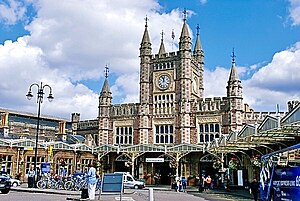
Back محطة بريستول تيمپل ميادس ARZ Gorsaf reilffordd Temple Meads Bryste Welsh Bahnhof Bristol Temple Meads German Estación de Bristol Temple Meads Spanish Bristolgo Temple Meads tren geltokia Basque ایستگاه راهآهن بریستول تمپل میدز Persian Gare de Bristol Temple Meads French Bristol Temple Meads vasútállomás Hungarian Stazione di Bristol Temple Meads Italian ブリストル・テンプル・ミーズ駅 Japanese
 Facade of the station | |||||
| General information | |||||
| Location | Redcliffe, Bristol England | ||||
| Coordinates | 51°26′56″N 2°34′48″W / 51.449°N 2.580°W | ||||
| Grid reference | ST597725 | ||||
| Managed by | Network Rail | ||||
| Platforms | 13 in use | ||||
| Other information | |||||
| Station code | BRI | ||||
| Classification | DfT category A | ||||
| History | |||||
| Original company | Great Western Railway | ||||
| Key dates | |||||
| 1840 | Opened | ||||
| 1871–1878 | Extended | ||||
| 1930s | Extended | ||||
| 1965 | Original platforms closed | ||||
| Passengers | |||||
| 2018/19 | |||||
| Interchange | | ||||
| 2019/20 | |||||
| Interchange | | ||||
| 2020/21 | |||||
| Interchange | | ||||
| 2021/22 | |||||
| Interchange | | ||||
| 2022/23 | |||||
| Interchange | | ||||
Listed Building – Grade I | |||||
| Feature | Temple Meads Station | ||||
| Designated | 1 November 1966 | ||||
| Reference no. | 1282106[1] | ||||
| |||||
| |||||
Bristol Temple Meads is the oldest and largest railway station in Bristol, England. It is located 118 miles 31 chains (118.39 mi; 190.5 km) away from London Paddington.[2] It is an important transport hub for public transport in the city; there are bus services to many parts of the city and surrounding districts, with a ferry to the city centre. Bristol's other major station, Bristol Parkway, is a more recent station on the northern outskirts of the conurbation. It is the busiest station in South West England.[3]
Temple Meads was opened on 31 August 1840, as the western terminus of the Great Western Railway. The railway, including Temple Meads, was the first to be designed by the British engineer Isambard Kingdom Brunel. Soon, the station was also used by the Bristol and Exeter Railway, the Bristol and Gloucester Railway, the Bristol Harbour Railway and the Bristol and South Wales Union Railway. To accommodate the increasing number of trains, the station was expanded in the 1870s by Francis Fox and again between 1930 and 1935 by Percy Emerson Culverhouse.[1] Brunel's terminus is no longer part of the operational station. The historical significance of the station has been noted and most of the site is Grade I listed.[1] In Britain's 100 Best Railway Stations by Simon Jenkins, the station was one of only ten to be awarded five stars.[4]
Thirteen platforms are in use,[5] numbered between 1 and 15, but passenger trains are confined to just eight tracks. Most platforms are numbered separately at each end, with odd numbers at the east end and even numbers at the west. Platform 2 is a bay platform at the west end which not used by passenger trains and there is no platform 14.[6]
Temple Meads is managed by Network Rail.[7] Most services are operated by the present-day Great Western Railway, with others by CrossCountry.
- ^ a b c Historic England, "Temple Meads Station (1282106)", National Heritage List for England, retrieved 4 January 2017
- ^ Padgett, David (June 2018) [1989]. Munsey, Myles (ed.). Railway Track Diagrams 3: Western & Wales (6th ed.). Frome: Trackmaps. map 6B. ISBN 978-1-9996271-0-2.
- ^ "ORR Statistics 2022-23" (PDF).
- ^ Morrison, Richard (9 December 2017). "Review: Britain's 100 Best Railway Stations by Simon Jenkins". The Times. Archived from the original on 9 July 2018. Retrieved 15 December 2021.
- ^ Cite error: The named reference
brimapwas invoked but never defined (see the help page). - ^ Jacobs, Gerald (2000). Railway Track Diagrams Book 3: Western (3rd ed.). Trackmaps. p. 5. ISBN 0-9549866-1-X.
- ^ "Two more stations for NR" Today's Railways UK issue 150 June 2014 page 13
© MMXXIII Rich X Search. We shall prevail. All rights reserved. Rich X Search
